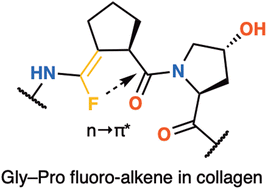We report the first experimental evidence for a fluoro-alkene amide isostere participating in n→π* donation, which stabilizes the collagen triple helix. Of the three amide positions in canonical collagen-like peptides, Gly-Pro, Pro-Hyp, and Hyp-Gly, triple helix stability stands to benefit from substitution of only the isomerizable 3° Gly-Pro amide bond with a trans-locked fluoro-alkene. A (Z)-fluoro-alkene isostere of Gly-trans-Pro was synthesized, and its effect on the thermostability of a collagen-like peptide triple helix was measured. The mixture of enantiomers, Boc-Gly-Ψ[(Z)CF![[double bond, length as m-dash]](https://www.rsc.org/images/entities/char_e001.gif) C]-L/D-Pro-OH, was synthesized in 8 steps with 27% overall yield, and the Fmoc-Gly-Ψ[(Z)CF
C]-L/D-Pro-OH, was synthesized in 8 steps with 27% overall yield, and the Fmoc-Gly-Ψ[(Z)CF![[double bond, length as m-dash]](https://www.rsc.org/images/entities/char_e001.gif) C]-L/D-Pro-Hyp-OBn diastereomers were separated. The Gly-Ψ[(Z)CF
C]-L/D-Pro-Hyp-OBn diastereomers were separated. The Gly-Ψ[(Z)CF![[double bond, length as m-dash]](https://www.rsc.org/images/entities/char_e001.gif) C]-Pro isostere installed in a collagen-like peptide forms a stable triple helix. By CD, the thermal melting (Tm) value of the fluoro-alkene peptide was +42.2 ± 0.4 °C, and the Tm value of the control peptide was +48.4 ± 0.5 °C, a difference in stability of ΔTm −6.2 °C. Deshielding of the fluorine nucleus in the 19F NMR spectra is evidence of a stabilizing n→π* electronic interaction.
C]-Pro isostere installed in a collagen-like peptide forms a stable triple helix. By CD, the thermal melting (Tm) value of the fluoro-alkene peptide was +42.2 ± 0.4 °C, and the Tm value of the control peptide was +48.4 ± 0.5 °C, a difference in stability of ΔTm −6.2 °C. Deshielding of the fluorine nucleus in the 19F NMR spectra is evidence of a stabilizing n→π* electronic interaction.
